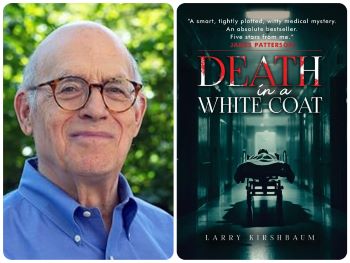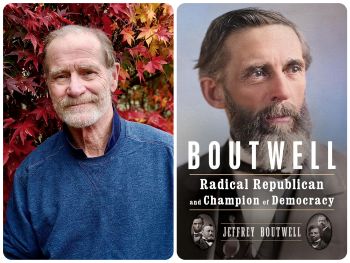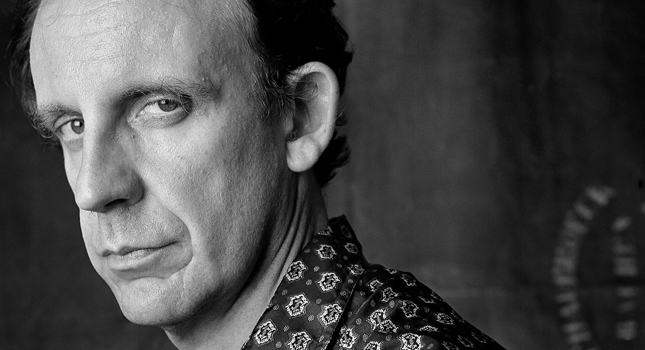The longtime publisher of bestselling thrillers reflects on writing his own page-turner.

Larry Kirshbaum’s Death in a White Coat delves into the murder of a medical-student prodigy — and into the motivations of the many women who wanted him dead. Full of suspense, the story keeps readers on their toes as each new secret is revealed. While this is his first novel, Kirshbaum, the former CEO of Warner Book Group, has had an extensive career in publishing and has worked with bestselling authors from James Patterson and David Baldacci to Scott Turow and Sandra Brown.
As a longtime publisher and literary agent, you’ve made a career out of championing other people’s books. What made you want to write one of your own?
This book actually goes back a number of years. As the head of Warner Books, our team had edited and published a number of world-class thriller authors from Jim Patterson to Brad Meltzer to David Baldacci to Nelson DeMille to Sandra Brown to Michael Connelly, on and on.
Mysteries are incredibly popular, as you know. Did that fact influence your decision to write in the genre?
Plus, I loved the mystery genre as great escape reading built around the premise of “who did it?” I thought I’d try the Agatha Christie formula of multiple characters as potential murderers — in this case, a trio of very bright and glamorous female [physicians] in training who might have each had different romantic reasons for wanting revenge to kill off a brash, rich, male medical student. I had some help on the medical side from a gifted female surgeon who vetted some of the details of how to kill a patient (hopefully not me) and get away with it. I also had help from some ex-NYPD detectives who became models for my favorite fictional male character, Barney Kazinsky, a veteran on the force who was undergoing some middle-age issues involving his daughter.
Death in a White Coat is told from multiple points of view. How did you manage the changes in perspective while keeping the narrative clear for readers?
The obvious set-up of the book had to be multiple points of view. I loved writing the different types of women, each of whom had their own particular reasons for revenge. If you watch streaming series on TV these days, it seems pretty hot and heavy, and I restrained myself from too many graphic details. I was trying to show the passions of men and women in a hospital environment, where there is an inevitable intimacy trying to save lives; the staff members are forbidden from becoming involved with medical students. The main issue with multiple points of view is trying to differentiate the characters so that the storylines of the book maintain clear delineations.
The medical field features prominently in the novel. What kind of research did you do in order to portray that world authentically?
In addition to the experts who helped authenticate the book, I developed a technical library of books on forensic pathology [and] heart and pulmonary treatments, as well as [on] criminal investigations. I struggled to read portions of these books, which have their own complex vocabulary. Now I understand why it takes many years for med students to evolve into medical specialists. It also took me about 15 drafts and seven years to write this book. My family was very patient, and there was plenty of critical help from all ages.
You’ve worked with an impressive array of thriller writers. Did any particular author’s style or approach to writing influence your own?
I tried not to imitate any other author’s style, and frankly, I’m not good enough to do so anyway. Great authors of what we call “genre fiction” are much more capable than given credit for in their labors. Precise, short paragraphs and chapters are the norm among those writers, who have come to realize that too many details are like too many cooks working one pot. Jim Patterson is brilliant in ending each chapter with a twist that makes you keep reading all night because you want to know what happens next.
What’s next for you?
I have been asked if I would consider a sequel. I self-published the book this time, and even with a crack publicity/marketing team, the sales have been modest. What has worked is a series of videos that I did for social networks like LinkedIn and TikTok. I’ve gotten a lot of hits on those (which last about one minute each), but the conversion to sales was not great. It was a first novel, and I could definitely improve in a second one. The beauty of being a writer is that it operates as a therapy session. I like to talk out loud, and since my wife is at work, I have our apartment all to myself. I work out a lot of editorial issues by conversing with myself. I should also confess that writing alone provides many hours of procrastination. I’m a media hound, and given our political discourse of late, that can be front and center in my life. Plus, I love to read. There are books in every room. But for now, I’m looking for a nonfiction subject as the next step. I must say, the characters from the current book have taken on a life of their own and frequently come back to haunt me during the post-midnight hours when I rattle around the house. Maybe someday they’ll return in book form.
Christina Hawkins, a senior English major at UMBC, recently completed an internship at the Independent.

